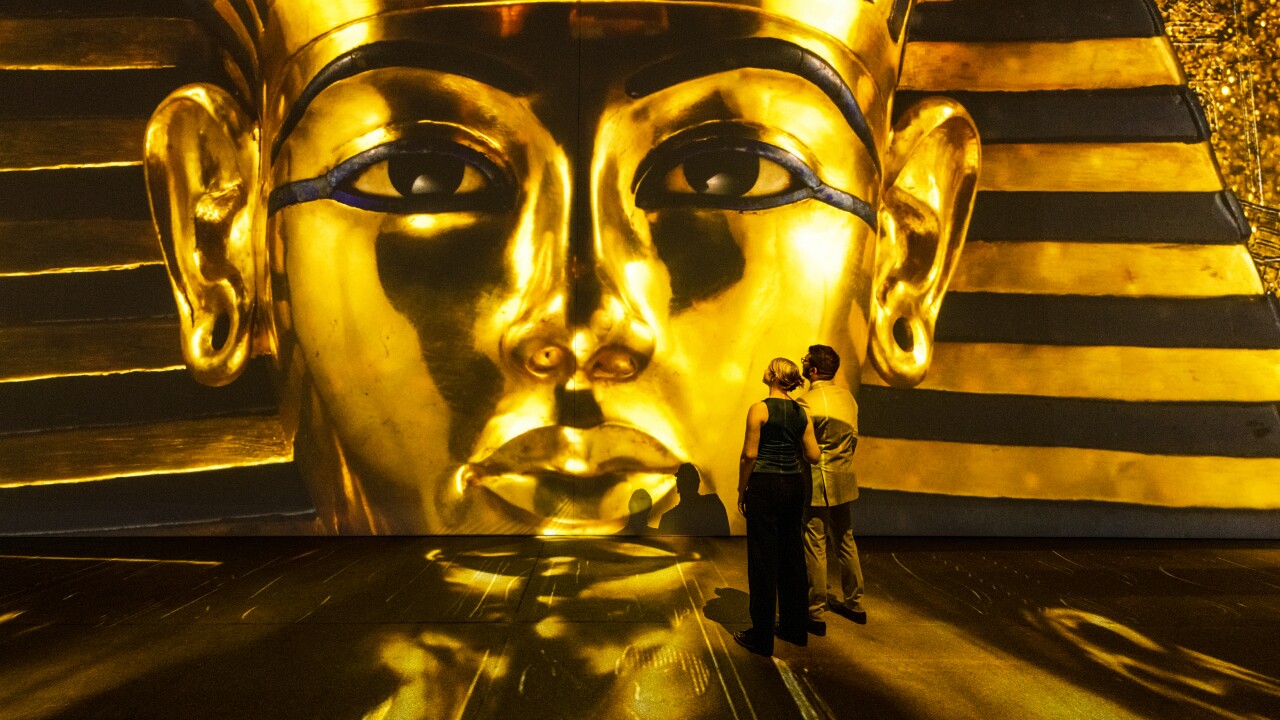
In the heart of Egypt’s desert landscape, a peculiar and captivating structure stands as a testament to the evolution of architectural prowess in ancient Egypt. The Bent Pyramid, also known as the Rhomboidal or Sneferu’s Pyramid, presents a captivating narrative of ingenuity, experimentation, and adaptation within the realm of pyramid construction. In this comprehensive blog post, we embark on a journey to explore the mysteries behind the Bent Pyramid and its significance in the annals of history.
A Monument of Curvature: The Bent Pyramid, located in the Dahshur necropolis, is a stark departure from the conventional pyramid design. Its unique feature lies in the abrupt change in angle approximately halfway up its sides, creating a distinct bent appearance. Built during the reign of Pharaoh Sneferu, the Bent Pyramid represents a significant transition in architectural techniques and design philosophy.
Architectural Evolution: The Bent Pyramid’s dual-angle design holds valuable insights into the evolution of pyramid construction. Scholars believe that the initial angle of the pyramid was too steep, potentially compromising its structural stability. In response, the architects made a sudden adjustment to a shallower angle. This architectural anomaly provides an invaluable glimpse into the experimentation and adaptation that characterized ancient Egyptian engineering.
Constructing the Unconventional: The construction of the Bent Pyramid required innovative techniques to manage the change in angles. Ancient builders used a combination of limestone and local mudbrick, with layers of limestone forming the pyramid’s smooth outer casing. The abrupt alteration in angle posed challenges in weight distribution and stability, highlighting the ancient architects’ keen understanding of structural mechanics.
Symbolism and Purpose: While the Bent Pyramid’s unusual design is attributed to engineering considerations, its symbolic significance cannot be overlooked. The pyramid represented the pharaoh’s ascent to the heavens and his divine connection. It is possible that the alteration in the pyramid’s angle was an intentional representation of the transition from earthly life to the afterlife, symbolizing the pharaoh’s journey to the divine realm.
Architectural Lessons and Legacy: The Bent Pyramid’s experimental design paved the way for subsequent pyramid construction in ancient Egypt. The lessons learned from its construction likely contributed to the successful creation of the iconic and flawless pyramids at Giza. Its architectural legacy resonates in the annals of history as a testament to the boldness and adaptability of ancient Egyptian builders.
Unlocking the Past Through Preservation: The Bent Pyramid, like many historical structures, has faced the ravages of time. Preservation efforts have been undertaken to conserve its unique features and ensure its survival for future generations. Archaeologists and researchers continue to study the pyramid’s construction techniques and historical context, shedding light on the architectural innovation of ancient Egypt.
Explore Best Attractions Around Cairo
Maximize your time in Cairo with our comprehensive Cairo day tours, ensuring that every moment is filled with wonder and discovery. Immerse yourself in a world of endless possibilities as we guide you through the captivating treasures of this ancient city. Marvel at the architectural marvels of the Great Pyramids of Khufu, Khafre, and Menkaure, standing as eternal symbols of the ancient Egyptian ingenuity. Delve into the heart of history at The Egyptian Museum, where an array of artifacts, stories, and mysteries are waiting to be uncovered.

Make the most of your layover in Cairo with our exciting Cairo Stopover Tour. Experience the iconic landmarks of this ancient city, including the Pyramids of Giza, the Sphinx, and the Egyptian Museum. With convenient transportation, expert guides, and a well-planned itinerary, this tour ensures an immersive and unforgettable adventure in a limited time frame View Tour Details

Day Trip to Pyramids from Cairo
Embark on a captivating day trip to the Pyramids from Cairo and immerse yourself in the mysteries of ancient Egypt. Our carefully curated itinerary ensures an unforgettable experience as you explore the iconic Pyramids of Giza, Sphinx, and more. Join us on this remarkable journey and witness the grandeur of the ancient world View Tour Details

Day Trip to Abu Simbel from Cairo by Plane
Embark on a mesmerizing day trip to Abu Simbel from Cairo by plane and immerse yourself in the awe-inspiring wonders of ancient Egypt. Discover the monumental temples of Ramses II and Queen Nefertari, marvel at the intricate carvings and colossal statues, and learn about the rich history and legends that surround this UNESCO World Heritage Site. With convenient flights, expert guides, and hassle-free arrangements, our all-inclusive tour offers an unforgettable experience for history enthusiasts and adventure seekers alike View Tour Details

Day Trip to Alexandria from Cairo by Car
Experience the allure of Alexandria on a thrilling day trip from Cairo by car. Explore the rich history and cultural heritage of this enchanting coastal city, visit iconic landmarks like the Library of Alexandria and the Catacombs of Kom El Shoqafa, and immerse yourself in the Mediterranean ambiance. With the convenience of private transportation, expert guides, and a well-crafted itinerary, this day trip promises an unforgettable adventure for history enthusiasts and wanderers alike View Tour Details
Related Egypt Tours Blog

Embark on an enchanting journey to the Giza Pyramids Complex, a testament to the ancient wonders of Egypt. Explore the iconic pyramids, unravel the mysteries of the Sphinx, and immerse yourself in the rich history of this UNESCO World Heritage Site. Join our guided tour to experience the awe-inspiring architecture, captivating legends, and breathtaking views of the Giza Plateau View Tour Details

The Saqqara Step Pyramid is a cornerstone of ancient Egyptian architecture, marking the transition from mastaba tombs to monumental pyramids. This guided tour takes you to Saqqara’s historical complex, where you’ll not only encounter the Step Pyramid but also explore fascinating tombs, chapels, and ancient structures View Tour Details

The Great Sphinx is an iconic masterpiece that has fascinated travelers for millennia. As you approach this enigmatic creature, you’ll feel the weight of history and the sense of wonder it evokes. Our expert guides will lead you through its mysteries and offer insights into the Sphinx’s role in ancient Egyptian culture View Tour Details
Bent Pyramid FAQs
- What is the Bent Pyramid? The Bent Pyramid, also known as the Rhomboidal or Blunted Pyramid, is an ancient Egyptian pyramid located in the Dashur necropolis, south of Cairo. It is one of the unique pyramids due to its distinct bent appearance.
- Why is it called the Bent Pyramid? The Bent Pyramid earned its name due to the change in angle halfway up the structure. The lower portion of the pyramid has a steeper angle, while the upper part has a shallower angle, resulting in its bent appearance.
- Who built the Bent Pyramid? The Bent Pyramid was built during the reign of Pharaoh Sneferu, who was a ruler of the Old Kingdom’s 4th Dynasty. Sneferu was one of the earliest pharaohs to construct pyramids.
- What was the purpose of the Bent Pyramid? Like other pyramids of the time, the Bent Pyramid was constructed as a tomb for Pharaoh Sneferu. It was intended to house his body, possessions, and offerings for the afterlife.
- What are the dimensions of the Bent Pyramid? The base of the Bent Pyramid measures approximately 189.5 meters (622 feet) on each side, and its original height was around 104 meters (341 feet). The angles of its slopes vary.
- Why does the Bent Pyramid have two different angles of inclination? The change in slope angle is believed to have been a result of construction issues. It’s speculated that the original angle was too steep and was then modified to prevent structural instability.
- Is the Bent Pyramid open to visitors? Yes, the Bent Pyramid is open to visitors as part of the Dashur archaeological site. Tourists can explore the exterior of the pyramid and, depending on conditions, might be allowed to enter the interior.
- Can visitors enter the interior of the Bent Pyramid? Visitors are sometimes allowed to enter the interior of the Bent Pyramid, offering a unique opportunity to experience the architecture and layout of an ancient pyramid.
- What can visitors see inside the Bent Pyramid? The interior of the Bent Pyramid features a descending corridor that leads to an antechamber and burial chamber. Visitors can observe the pyramid’s internal structure and architectural elements.
- Are there any artifacts found within the Bent Pyramid? The Bent Pyramid did not yield significant treasures or artifacts. It is believed that looters and grave robbers may have accessed the pyramid centuries ago.
- What are the theories behind the Bent Pyramid’s bent shape? There are several theories about why the pyramid’s angle was changed. Some suggest it was to prevent structural instability, while others propose it was due to engineering miscalculations.
- How does the Bent Pyramid compare to other pyramids in Egypt? The Bent Pyramid is distinctive for its bent shape and dual slope angles. It represents an experimental phase in pyramid construction and was succeeded by the construction of the Red Pyramid at Dashur.
- Can visitors see other pyramids near the Bent Pyramid? Yes, visitors to Dashur can also explore the Red Pyramid, which is nearby. The Red Pyramid is known for being the world’s first successful attempt at constructing a true smooth-sided pyramid.
- What makes the Bent Pyramid an important historical site? The Bent Pyramid provides valuable insights into the engineering challenges and experimentation that ancient Egyptians faced while developing pyramid-building techniques.
- Is the Bent Pyramid part of any guided tours? Yes, the Bent Pyramid is often included as part of guided tours that visit various archaeological sites in the Giza and Dashur areas.
- Are there any ongoing research or restoration efforts at the Bent Pyramid? Ongoing research and restoration efforts take place at the Bent Pyramid to ensure its preservation and to gain a deeper understanding of its construction and history.
- What does the Bent Pyramid symbolize in Egyptian culture? The Bent Pyramid symbolizes the innovative spirit and adaptability of ancient Egyptian architects and engineers as they experimented with different pyramid-building techniques.
- Is there any significance to the Bent Pyramid’s location in Dashur? The location of the Bent Pyramid in the Dashur necropolis reflects the importance of this area as a burial site for pharaohs during the Old Kingdom.
- Can I take photographs inside the Bent Pyramid? Photography regulations can vary, but in general, photography might be allowed inside the Bent Pyramid for personal use. However, some restrictions might apply.
- What should I keep in mind when visiting the Bent Pyramid? When visiting the Bent Pyramid, respect the historical site, follow the rules and regulations set by authorities, and enjoy the opportunity to witness a unique piece of ancient Egyptian architecture and history.

